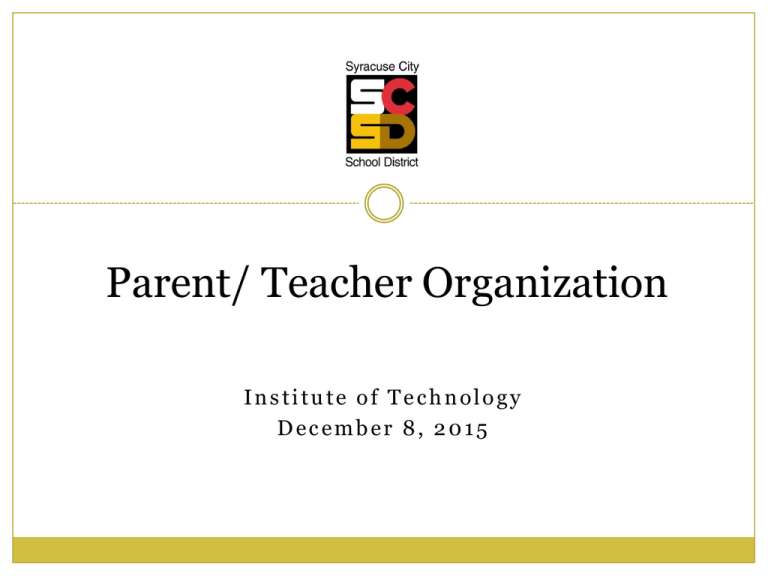Parent/ Teacher Organization
advertisement

Parent/ Teacher Organization Institute of Technology December 8, 2015 2 Why Common Core 3 Three Shifts in ELA Regular practice with complex text and academic language Reading, writing, and speaking grounded in evidence from texts, both literary and informational Building knowledge through content-rich nonfiction High School English 4 Students will: Closely and critically read complex works of literature and informational texts Communicate about texts in writing and through class discussions Interpret what they read and present analysis using appropriate examples and evidence from text Assess the strength of an author’s or speaker’s points and assumptions based on evidence from the text High School English 5 Students will (cont): Expand on literary and cultural knowledge by reading great classic and contemporary works representative of various time periods, cultures, and worldviews Develop skill, fluency, and concentration to produce high-quality writing over multiple drafts Staircase of Complexity 6 7 Increase time for conversation at How You Can Help home. Discuss classroom assignments, activities, and homework. Ask your child about his/her academic goals and interests. Assist in gathering sources of information of college and career opportunities. Begin to explore colleges and other postsecondary options that are of interest to your child. Be an Active Partner 8 Reach out to your child’s teacher and ask: Is my child becoming an effective writer? Is my child becoming more skilled at reading and understanding challenging material? With what does he/she struggle? What extra support can I provide at home to reinforce what you are teaching in class? How can I ensure that my child is developing good study habits for high school and beyond? Common Core Mathematics Program Focus Coherence Rigor Focus – Learn more about less 10 Students must: Parents Can: Spend time on fewer Know what the priority concepts work is for your child for their grade level Spend time with your child on priority work Ask you child’s teacher about their progress on priority work Coherence- Skills Across the Grade Level 11 Students Must: Parents Can: Keep on building Be aware of what your learning year after year child struggled with last year and how that will affect learning this year. Advocate for your child and ensure that support is given for “gap” skills – negative numbers, fractions Rigor – Balance of understanding and skill 12 Students Must… Parents Can… Understand why the Notice whether your child math works. Make the math work. Talk about why the math works Prove that they know why and how the math works really knows why the answer is what it is Ask your child to explain the steps they are doing and why the steps work Ask your child to do the Real-World math at home Conceptual Understandings in High School 13 Focus Areas of Rigorous Instruction of Conceptual Understanding and Fluency 8 Alg. 1 Geo. Linear algebra and linear functions Seeing structure in expressions and reasoning with equations and inequalities Congruence, similarity, expressing geometric properties with equations and modeling with geometry Alg. Polynomial, radical, rational and trigonometric functions 2 Rigor – Balance of understanding and skill 14 Students Must… Parents Can… Spend time practicing Push children to – problems on the same idea know/memorize basic math facts/perform skills in Algebra Know all of the fluencies your child should have and prioritize learning of the ones they don’t Fluencies in Grades 6- Algebra 2 15 Standard Required Fluency 6 6.NS.2,3 Multi-digit division Multi-digit decimal operations 7 7.EE.4 Solve px + q = r, p(x + q) = r 8 8.EE.8 Solve simple 2x2 systems by inspection Alg.1 A-APR.1 Fluency in adding, subtracting, and multiplying polynomials Alg. 1 A-SSE.1b Fluency in transforming expressions and chunking Geo G-SRT.5 Fluency with the triangle congruence and similarity criteria Geo G-GPE.4, Fluency with the use of coordinates to establish geometric results, calculate 5, 7 length and angle, and use geometric representations as a modeling tool Geo G-CO.12 Fluency with the use of construction tools, physical and computational Alg.2 A-APR.6 Divide polynomials with remainder by inspection in simple cases Alg.2 A-SSE.2 To see structure in expressions and to use this structure to rewrite expressions Alg.2 F-IF.3 Fluency in translating between recursive definitions and closed forms 16 • Mathematical Practices • • Habits of Mathematicians • • • • Make Sense of problems and persevere in solving them Reason abstractly and quantitatively Construct viable arguments and critique the reasoning of others Model with mathematics Use appropriate tools strategically Attend to precision Look for and express regularity in reasoning Brain Research 17 No “Math Brain” The brain has plasticity – it changes and adapts Mistakes are GOOD for the brain! Carol Dweck’s Work 18 Fixed Mindset Growth Mindset Intelligence is fixed Intelligence can be Avoid challenges Give up easily Sees efforts as fruitless Ignore useful feedback Want to maintain looking “smart” Mistakes = failure developed Embraces challenges Persists despite obstacles Sees effort as necessary for success Mistakes = Learning Changing Language 19 If kids say: Try: I got it wrong So what did you learn I can’t do it I’m not good at this I’m not good at math from the mistake? What are some strategies that you can try? What are you missing? You can train your brain to do math with effort On-Line Resources 20 Khan Academy Jmap.org E-Math Instruction Castle Learning Accelerated Math Questions? 21





